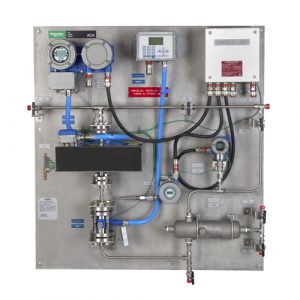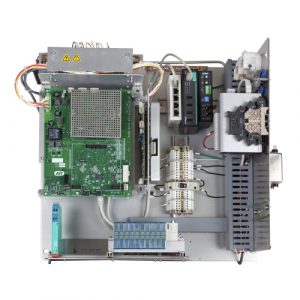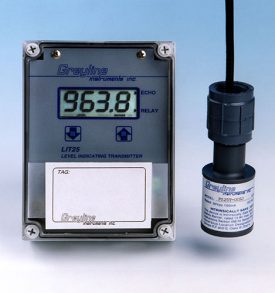Description
Doppler Flow Meter
Doppler flow meter measure flows from outside a pipe with a clamp-on sensor. Doppler meter continuously transmits high frequency sound (640MHz) that travels through the pipe wall and into the flowing liquid. Sound is reflected back to the sensor from solids or bubbles in the fluid. If the fluid is in motion, the echoes return at an altered frequency proportionate to flow velocity. Doppler flow meters continuously measure this frequency shift to calculate flow.
Measure Flow of dirty or aerated Liquids from Outside a Pipe
The Doppler effect was first documented in 1842 by Christian Doppler, an Austrian physicist. We hear everyday examples of Doppler: the sound of a train whistle changing pitch as it passes by, or the exhaust noise from a race car as it speeds past our location.
The Doppler technique only works on liquids that contain solids or gas bubbles to reflect its signal. These are “difficult” liquids that may damage regular flow meters: slurries, sludge, wastewater, abrasives, viscous and corrosive chemicals. Because the sensor mounts on the outside of the pipe, there is no pressure drop and no obstruction to flow.
For best performance Doppler sensors should be mounted away from turbulence creating devices like pipe elbows and tees, and away from velocity increasing devices like controlling valves and pumps. Typical accuracy is ±2% of full scale.
Doppler instruments include a clamp-on ultrasonic sensor, connecting cable and an electronics enclosure which can be mounted at a convenient location nearby (within 500 ft / 152 m). Sensors can be rated intrinsically safe for mounting in hazardous-rated locations.
Transit Time Flow
Transit Time flowmeters measure the time it takes for an ultrasonic signal transmitted from one transducer to cross a pipe and be received by a second transducer. Upstream and downstream time measurements are compared. With no flow, the transit time would be equal in both directions. With flow, the sound will travel faster in the direction of flow and slower against the flow.
Very accurate timing circuits are required but 1% accuracy is quite typical when the transducers can be mounted on a pipe section with the evenly distributed flow.
Because the ultrasonic signal must cross the pipe to a receiving transducer, the fluid must not contain a significant concentration of bubbles or solids (less than 2%). Otherwise, the high-frequency sound will be attenuated and too weak to traverse the pipe. Applications include potable water, cooling water, water/glycol solutions, hydraulic oil, fuel oils and chemicals.
Transit Time transducers typically operate in the 1-2 MHz frequencies. Higher frequency designs are normally used in smaller pipes and lower frequencies for large pipes up to several meters in diameter.
Description
It’s ideal for flow troubleshooting, balancing and checking the performance of permanent flow meters. The new PDFM 5.1 is fast and easy to operate – you can mount the sensor on the outside of a pipe in less than a minute. Use the built-in keypad and calibration menu to set up the flowmeter for your application. The PDFM 5.1 works on any liquid containing bubbles or solids and is recommended for “difficult liquids” like wastewater, slurries, sludge, chemicals, viscous liquids, and abrasives. Measures flow through most metal and plastic pipes including PVC, ductile iron, carbon steel and stainless steel.
The Greyline PDFM 5.1 is AC/DC powered with built-in NiMH batteries and external charger. With its 4-20mA output, you can use the PDFM 5.1 as a spare transmitter in critical applications. For flow studies and troubleshooting use the built-in 300,000 point Data Logger. Retrieve data logs with ‘Greyline Logger’ software – included free with each PDFM 5.1. Connect the USB output directly to your PC or Laptop to download data logger files.
The PDFM 5.1 includes a non-intrusive Doppler ultrasonic sensor for pipes from 1/2″ to 180″ (12.5 mm to 4.5 m) diameter, a stainless steel sensor mounting bracket and clamps, coupling compound and AC charger with a rugged IP67 carry case. It operates up to 18 hours from internal batteries and recharges overnight.
PORTABLE DOPPLER FLOW METER SPECIFICATIONS
SCOPE: This specification covers a portable, ultrasonic Doppler-type flow meter as manufactured by Greyline Instruments, Largo, Florida / Long Sault, Ontario. This instrument shall provide for non-intrusive flow measurement, indication, totalizing, transmitting and data logging of the flow rate in a full pipe.
GENERAL:
Each portable Doppler flow meter shall have the following design features and engineering specifications:
A. PERFORMANCE SPECIFICATIONS
- Measure forward and reverse flow ± 0.1 to 40 ft/sec (± 0.03 to 12.2 m/sec).
- Have an accuracy of ±2% of full scale on most wastewater applications. Have linearity of ±0.5% and repeatability of ±0.25%.
- Operate on liquids with entrained particles or gases of 100 microns or larger and minimum concentrations of 75 ppm.
- Operate from the outside of common pipe materials including: carbon steel, stainless steel, ductile iron, copper, PVC, FRP, ABS and other selected engineering materials.
- Operate on AC/DC power.
B. TRANSDUCER
- Have a single-head, clamp-on transducer with twin piezo-electric ceramic transmit and receive crystals encapsulated in epoxy resin and a stainless steel housing.
- The transducer shall be solid state and transformer isolated, and operate at 640KHz.
- The transducer shall be waterproof and operate at temperatures from -40°F to 300°F (-40°C to 150°C), and withstand accidental submersion to 10 psi.
- The transducer shall be designed to install on pipes with inside diameter ranging from 1/2″ to 180″ (12.5 mm to 4.5 m).
- Have a 12 ft (3.6 m) long flexible, shielded coaxial pair cable extending from the transducer to the electronics.
- Shall include Manufacturer’s recommended sensor coupling compound and adjustable stainless steel sensor mounting clamp.
C. ELECTRONICS
- Have a portable ABS electronics enclosure with a padded, watertight IP67 carrying case. Total weight shall be less than 14 lbs (6.5 kg).
- Electronics shall be designed for continuous operation at temperatures from -10° to 140°F (-23° to 60°C).
- Have a built-in 5-key calibration keypad with operator selection of parameters through visual prompts from a menu calibration system. Systems requiring calibration by Parameter codes or external calibrators shall not be accepted.
- Have user-selectable menu languages including English, French and Spanish.
- Have a white, backlit matrix display indicating flow in user-selected engineering units, totalized flow, units of calibration, and signal strength.
- Have display backlight brightness adjustment for reduced power consumption.
- Have flow proportional 4-20mA output rated to maximum resistive load of 500 ohms.
- Have a built-in 300,000 point data logger, USB output and connecting cables. Data logger shall support time and date-stamped logging and generate formatted flow reports including total, average, minimum, maximum and times of occurrence.
- Include Windows software for data log retrieval, graphing and export.
- Have automatic signal strength and signal confidence monitoring.
- Have keypad adjustable signal cutoff to reduce interference.
- Shall include an external charger with 100-240VAC 50/60Hz input.
- Shall include an internal NiMH rechargeable battery with minimum capacity for 18 hours continuous battery operation.
- Have a battery status indicator with automatic low battery shut off and battery overcharge protection.
- Have user-selectable “sleep mode” synchronized to data logger sample rate for reduced battery power consumption.
D. OPTIONAL FEATURES FOR INSERTION IN SPECIFICATION AS REQUIRED:
- Include additional 150 g. manufacturer’s recommended ultrasonic sensor coupling compound.
- Include 50 ft (15 m) length Sensor Cable extension complete with connecting plugs.
E. MANUFACTURER
The instrument shall be a Model PDFM 5.1 Portable Doppler Flow Meter as manufactured by Greyline Instruments Inc., and warranted against defects in materials and workmanship for one year.
















